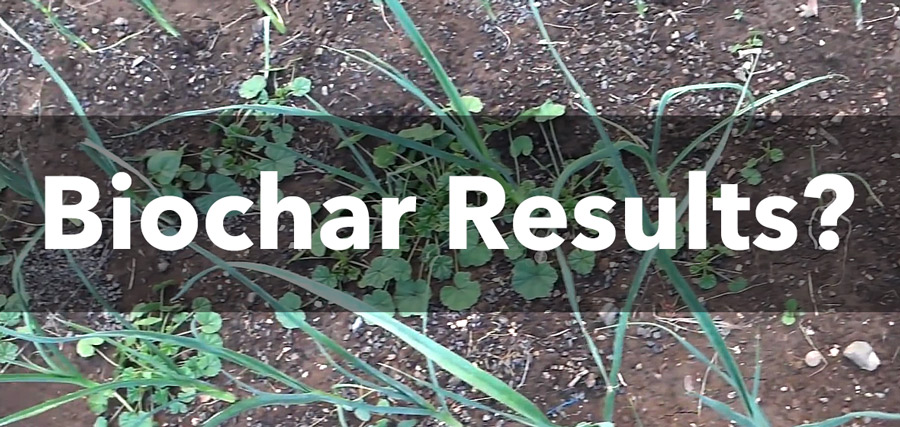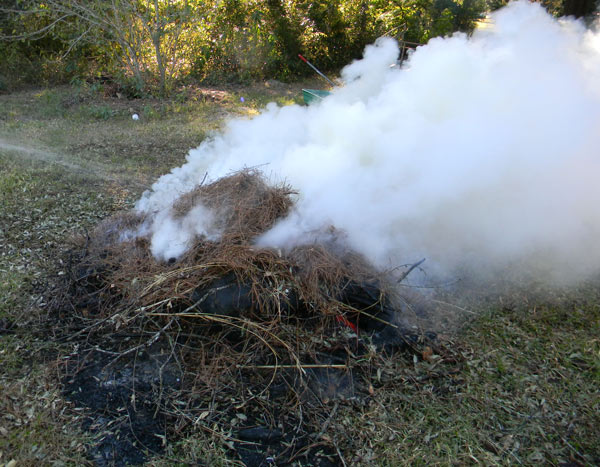
Does biochar really work?
I’ve asked that question and have been asked that question many times. But I never bothered giving biochar a real test. I threw some into my gardens and some into my compost but never really made a lot, added a lot or paid any real attention to the long term pluses or minuses.
Fortunately, I have friends that do conduct experiments… like Steven:
It’s interesting that his lettuces died… and then in a subsequent year, the leeks went nuts.
Raw charcoal/biochar does seem to have a negative effect when first used as it sucks up the nutrition in the soil.
Later, however, it acts as a soil reserve for those good things as well as in-ground condo developments for beneficial bacteria and fungi.
Biochar Plans
I plan on making a big batch of biochar and then soaking it in my anaerobic compost tea before adding it to some of my struggling garden beds.
Alternately, I’ve heard you can soak biochar in urine to turn it into a long-term fertilizer. Or just use urine right in the garden, as I demonstrated in yesterday’s video:
Throwing biochar in a compost pile and then later applying the finished compost to your garden gives your plants both the benefits of biochar and the benefit of compost. This is a method I know many gardeners practice.
Simple Biochar Making
Though you can create special biochar kilns and really geek out about making biochar, I approach it more like I approach most composting and just light a big fire, then let it burn a bit, rake it around, then water it out with the hose and gather the charcoal.
Steven has a nice trench method for making biochar I would try if it wasn’t so devilishly hard to dig holes here because of the clay and rocks:
Biochar, no matter how you make it, has promise as a long-term soil amendment. Steven’s experimentation is pushing me to try some experiments of my own. It’s monsoon season right now so I haven’t gotten together enough dry wood to really make awesome biochar, but one of these days it will be clear for a few days in a row and I’ll get to light up a nice fire.
Then it’ll be time to start some crazy biochar action in the garden. So, to answer the question “does biochar really work,” it seems the answer is “yes” based on Steven’s research. More testing is in order, however, as these is a wide range of application amounts possible and great differences in soil and crops.
Anyone else feeling like making a fire? I’m psyched.


4 comments
Interesting. I have read several accounts of archeological sites ranging from the Orkney Islands to the Amazon where people used charcoal to treat fields in the distant past.
I use my fireplace waste, lots of ash and whatever char remains, usually not much, dumped into deep pits in my garden. In the spring I cap them with soil and plant overtop. Seems to work great, but no way to tell how much is due to the char and how much to a deep layer of garbage.
The last two years I had large bonfires in my back yard, leaving big round burnt patches covered in ash and lots of charcoal. Last year I scattered lettuce and arugula seed all over it and it grew great. This year I am trying tobacco, daikon radish and tomato on the new patch. All are doing well, and the patch from last year reseeded itself with arugula and is also really good. I did add an NPK topdressing to get past the early days when the charcoal was sucking up all the N, since the underlying soil is a heavy red clay, pretty nutrient-poor.
Go David!!!
[…] seeing Steven’s success with biochar and leeks – and after getting really sick and tired of how gluey the clay can get here – […]
Do it to it! I like that I put my earliest experiments in without any additional nutrients to see what happened with that. the plant growth was like a graph that reversed itself over time. Crazy. I also like that I did divided sections in the same beds as it provides more graphic and believable results. When I show it to people they are typically very impressed. A healthy skeptic would ask questions and reserve at least a little doubt, but any gardener that is not at least intrigued is trippin’. I thought it would almost surely end up working all along, but I didn’t expect the 400% to 600% (guessing, but something like that) difference between 0% and 10%.
I think a lot of people make the mistake of applying it in small amounts all over the place. I think that probably has a less useful overall effect and it is probably not going to be an observable effect if the quantities are very small. Sure, it will accumulate if you keep it up, but it takes 10 minutes to think up and lay out a good experiment and do that instead, then you can observe the results for a long time and you are sure of the quantities. Now that I did this 0%/5%/10% experiment, 10% is my new benchmark and I’ll do most future experiments or applications at 10% An easy way to measure is to rake the bed flat, press it lightly with a piece of plywood and then add a certain depth to the top of the bed, one inch dug in 9 inches deep is 10% etc… but even if you only have a small amount, I would concentrate it at 5% or more in a small area and whenever you have more, just expand it slowly.
I like the trench a lot, but the open piles are great too. If you take a little time to stack them tall and vertical, they burn super fast and more of the char drops onto the pile. They still take a little bit of managing, but they are very fast burning. I’ve done that with pallets as well. Run a magnet through the pile to pick up the nails and you’re good to go.
One cool thing about biochar is that it serves many of the purposes of organic matter without rotting. As you said having high amount so of organic matter in the soil is not really natural, probably because it rots so fast. Organic matter and compost additions are an endless treadmill and as soon as you quit, the area will revert pretty quickly to it’s natural local state as nutrients wash out and get carried off or whatever it is that happens. There are very few additions we can make that have a permanent effect and none I know of as promising as biochar. Go for it citizen scientists!
Comments are closed.